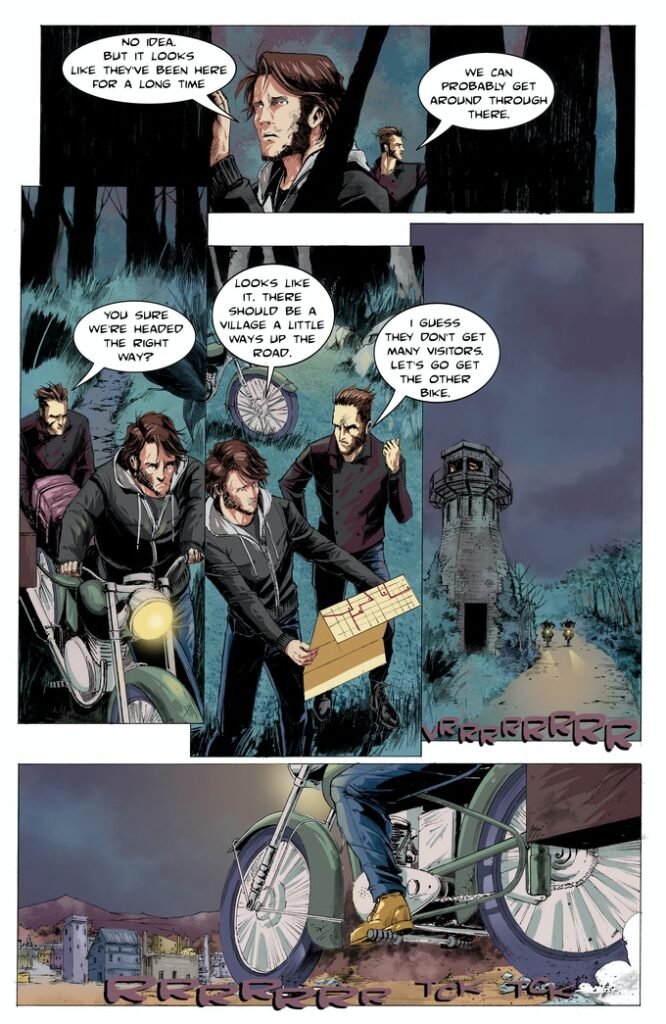Writer: Benjamin Ruffett
Art: Andrey Portilla
Colours: Cristian Ramirez
Witching Hour Comics, 2022
TWO YOUNG MEN, soldier age, zoom on motorcycles on a primitive road through a heavy forest at night off the eastern shore of the Black Sea near-about the place where Greek myths say Jason and the Argonauts journeyed to world’s end to find the Golden Fleece. Gloomy scenery is standard in SIEGE TOWN, a new title out in 2022. Moody panels of art carry the action, while writer Benjamin Ruffett often stands back and supplies words only when people happen to be talking. Suspense creeps in right away.
In a small town discovered on a detour through the woods, the host at the only hotel-looking building in town enters the stage like gramma in the woods at her candy-crusted house. He is caricatured tall and bony, with a pointy nose, and pointy chin and ears to match.

The art is loose, yet finely detailed only shredded by shifting patches of colour that dissolve the precise layout into jumbled impressions as one has in real life in raw perceptions glimpsed for an instant as Picassoesque faces and places at odd angles before the filters of the mind project sensible shapes. The art by Andrey Portilla in combination with Cristian Ramirez glistens.
This is how I ended up inside on the creaking floorboards, listening to these three characters on the stage, turning one way and another to look at them and size-up the situation. That’s all you get to hear. From there my lips are sealed; except my favorite scene: less than a minute inside the door, the two alert guys swivel their heads to look at each other, sharing a deep skepticism.
Blood and violence occur later, that gives nothing away. All along, though, despite some exaggerated features, everything is real. These look like real people starting something, and even by the end submerged in the last two wordless pages, looking like they might have more to finish.
I hope so. The story could be a one-shot, yet several tantalizing threads implicate a larger plot with more to come. The first is language.
Alongside the expansive art, the story is propelled by dialogue and sparse sound effects, with a lot of untranslated Russian, but for the beginning and end when persons who speak English are able to talk to the two adventurers, who turn out to be Americans that came here not knowing the language. The situation looks like bad holiday planning.
The place and time are still more curious. On the first page, a brief Rod Serling-type introduction sets the scene:
“1953. Southeast of Anapa, Russia … It is a resilient tract of country, having survived centuries of sieges by Asiatic nomads, the Russian empire, the Ottomans, Nazi Germany, and Romanian storm troopers. The area does not take kindly to visitors.”
Indeed. This area in the Caucasus is an insulated tract of land at the edge of the known world from a Western perspective, nestled on the edge of the Asian steppe, where nomad horse archers congregated and stayed to rule until Russia united to thwart them. A little farther south in Georgia, the Soviet leader Stalin was born; and in 1953, the date of the story, Stalin died. Maybe not a coincidence. Just how and why did these two adventurers reach this place?

Lies, corruption, conspiracies, and espionage are like dinosaur bones, giving up only a small fraction of what actually existed in the examples we know, and nothing of what exists now. One can only imagine, if not know for sure that US agents of various sorts leapt into action to interlope in Russian affairs as soon as the iron grip of Stalin slipped.
According to a chronicle of CIA activity, Killing Hope (2004), by William Blum, nine US surveillance planes were shot down by the Soviets in the early 1950s, and by 1992, 730 US airmen were captured on spy flights. In addition, Russian nationals were recruited, sometimes harshly, and dropped by air into the country to serve as spies, instigators, and saboteurs. This game plan against the Soviet Union and its allies was adopted by both the CIA and NATO from their origins following World War Two. Covert activities were widespread and earnest, “underwritten heavily by unvouchered CIA funds,” according to the secret 1956 Doolittle Report.
My bet says our two adventuring Americans were shot down in this unlikely place, and commandeered some bikes. Current conditions in the southern Caucasus give credence to the idea that American agents were there in 1953. An editorial in The Commonwealth news magazine by Irakli Dzhaparize (Apr 8, 2018) observes covert activities today that reflect long-standing American and British interests in penetrating this pivotal region in the world.
“The CIA has not wasted time since the declaration of independence in this region and seized influence (mainly through money) on non-governmental organizations, politicians, media, religious organizations, and human rights advocates. For this reason, indigenous minorities and their territories are attacked by the authorities trying to get rid of dissidence … Contradictions are growing, which as a result will allow the CIA to apply the strategy of ‘managed chaos’ and take these territories.”
This interpretation of current events in the Caucasus was also observed by Dutch political economy professor Kees van der Pijl in a recent book about conspiratorial events in Ukraine surrounding the 2014 downing of Malaysian airliner MH17. There, NATO and US generals, state agents, and oligarchs make no secret about aiming to fracture and desolate the country in a pattern we know all too well from earlier models in Korea, Vietnam, and Iraq firebombed back to the Stone Age.
Siege Town is a good cautionary tale for would-be spies and collaborators aiming to change the fate of a people: warning that others have missions of their own and can change your fate instead. In the last chapter, a hulking Russian in an old trooper’s overcoat and cap speaks English, echoing the ominous opening to the story: “When I was young, we held back the blitzkrieg in slim corridor to hell. They threw everything they had at us. Mother Russia did not back down. It was sacrifice we all had to make. We knew what we were fighting for.” This evidently is the hard message the author wants us to remember.

[Editor’s note: Siege Town was the subject of a successful Kickstarter campaign which ended in March 2022. It is available on Amazon: https://www.amazon.co.jp/-/en/Benjamin-Ruffett-ebook/dp/B09VJYP6DW ]

